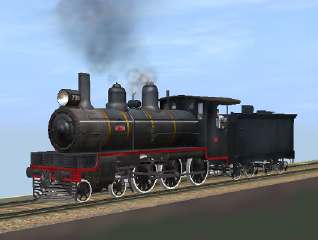CCG/Modelling: Researching Data and Testing a Steam Locomotive
Contents |
Researching Data and Testing of a Steam Locomotive
Steam locomotives are quite complicated and many of the performance values entered as tags in the config.txt file interact with, and influence, each other. This can make it difficult to firstly choose starting values for the various input data, then to vary those values during testing within Trainz to produce a smoothly operating and realistically performing locomotive.
Using the Steam Locomotive information in this document and entering data for the various settings, the following may assist in developing a workable and realistic steam locomotive.
Research and Record:
1. the locomotive data and convert the data to metric values (the config.txt is ALL in metric);
2. the dimensions for the cylinders, bore & stroke;
3. boiler working pressure;
4. the specific locomotive hauling rating on what percentage grade (for cut off and speed);
5. the normal service speed with that load on the level, and its practical maximum speed; and
6. the water and coal consumption per hour (sometimes the hardest to find).
Input in the Config.txt file:
1. piston-area in sq metres;
2. piston-volume-max in litres;
3. piston-volume-min of the cylinder at 3% of the maximum volume;
4. set the initial-boiler-temperature at 80 - 85% of working boiler temperature;
5. set the safety valve values (see comment below);
6. suggest firebox-to-boiler-heat-flow, and burn-rate, of 0.06 as a good starting point;
7. boiler-to-piston-flow and piston-to-atmosphere-flow usually 0.0035;
8. the water-injector-rate at 15 to start, shovel-coal-mass at 35, and fuel-energy value at 20;
9. the boiler-volume approximately 10x real volume (see the table in the Content Creation Guide for three sets of figures that cover "proportionally" appropriate loco sizes).
Testing Suggestions:
1. starting with the loco and train on a long level section adjust the speed and power with the boiler to piston and piston to atmosphere flows;
2. carefully adjust the "firebox-to-boiler-heat-flow", the "max-fire-temperature" along with the "fuel-energy" settings (the boiler steam production can be made to be prototypical and produce enough steam providing the locomotive is hauling a train within its capacity and is driven with the correct use of the valve gear);
3. during this process, the injector is tuned in to feed enough water at just below maximum demand;
4. the shovel rate is used to adjust the amount of coal used and to supply heat;
5. the fuel value is another adjustable in the fire parameters;
- This should give a config.txt file that reasonably reproduces the real performance in Trainz, hauling standard Auran cars (most users don't vary or adjust the rollingstock config.txt files, yet it is not difficult to find tonnage and speed numbers for the locomotives).
- A comment on the safety valve settings: Try not to waste water through the safeties, keeping the settings close together (by setting the safety valves to 15Kpa (2lbs) difference) allows for a rapid release to bring the pressure back quickly, thus emulating the action of "Pop" type valves. This is both deliberate and prototypically accurate, to prevent over pressure and ultimately the big bang.
- More practically in Trainz, it prevents water wastage.
Some third party spreadsheets for calculating engine spec. values can be found by searching the Trainz Forum
Narrow Gauge Geared Locomotives
These engines have relatively small cylinders and they use a miniscule amount of water. To get the water usage up to an appropriate prototypical rate, you will need to multiply the cylinder volume by the gear ratio then you will get it to use the appropriate amount of water. The cylinder volume makes no difference to the performance, just the water usage, so for a geared locomotive such as a Shay, Climax, or Heisler, by multiplying the cylinder volume by the gear ratio then the amount of water used will be realistic. It is the piston area / boiler pressure that gives the output force / power that drives the locomotive and train.
For example, a typical Shay locomotive may have a gear ratio quoted as 3.3:1 (3.3 to 1). Multiply the boiler volume by 3.3 to give a realistic water usage.
Previous Page . . . . Next Page
